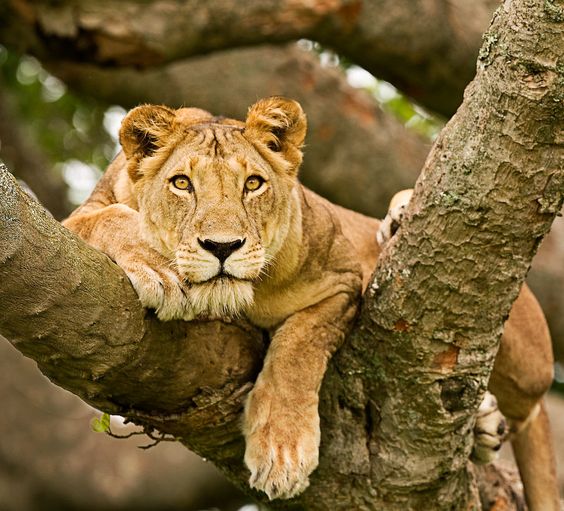- March 26, 2021
- Posted by: Administrator2
- Categories: Blog, Current News, Latest News, Uganda News, Uganda Parks, Uganda safaris

The tree-climbing lions in the Ishasha sector are a great source and pull of tourists in Queen Elizabeth national park. The killing of the six lions in the Ishasha sector has been a deep stab in the tourism industry.
In March 2021, Uganda Wildlife Authority released a public notice that left the general public shocked. The press release informed the public of the sudden killing of six lions, in the Ishasha sector; allegedly by poisoning.
The killing of the six tree-climbing lions in the sector of Queen Elizabeth national park has devastated the conservation efforts of wildlife in Uganda. The Lion Carcasses found in the sector were examined and it was determined that they were poisoned. Additionally, some body parts were missing.
Suspects arrested
Eight dead vultures were found next to the carcasses of the lions. The death of the four lions led to further investigations that led to the arrest of four suspects.
Miliango Davi 68 years, Aliyo Robert 40 years, Tumuhire Vincent 49 years and Ampurira Brain 26 years are the four suspects that were arrested. These were arrested by the Uganda wildlife authority with the help of the Uganda peoples’ defense policy of Kanungu district kihihi sub country and Rusoroza parish kyenyabutongo village.
These people were arrested on 23rd March 2021.
The suspects led the police to the terrace of the lion’s carcasses missing parts. The location of three heads of the lions was found under a tree, with one leg buried in the ground. ‘One lion leg was dropped off in the park’ as the suspects explained the location of the missing parts.
More evidence was found in the home of one of the suspects – Tumuhire Vincent. These included one panga, one hunting net, and two spears in his banana plantation. Two jerrycans of lion fat oil and three bottles containing a chemical called furadan were found. It is suspected that the arrested suspects used these materials to kill the lions.
With the arrest of these people, more investigations are still done to tract down all the lion killers and the arrested will faced the law as required for the justice of the lions.
Conservation Efforts sidetracked
The conservation and protection of wildlife in protected areas is an essential element in the conservation of Wildlife in Uganda. The Uganda wildlife authority with tourism stakeholders have put more emphasis on the importance of wildlife conservation. All concerned bodies in the tourism sector have continued to condemn the destruction of protected areas and killing of wildlife.
The outcome of wildlife conservation have not only benefited the government, but the local communities surrounded by the protected areas. The benefits are in form of increased revenue from foreign exchange earnings
Queen Elizabeth national park is among the top national parks in Uganda. The park has been and continues to be a great benefit to the government and the local communities surrounding it.
According to the news release, UWA indicated that the park has been the great source of revenue to Uganda. The park contributes 10% of the country’s GDP, 23% from the foreign export earnings and 1.6 billion contributions to the economy from natural tourism.
Despite the loss of these lions, there are still more lions to be explored in the Ishasha sector of Queen Elizabeth national park.
Ishasha Sector
The Ishasha sector is among the two sectors of Queen Elizabeth national park. With the Ishasha sector on the south-western side of the park and the Mweya peninsular on the northern side. The Ishasha sector is famously known for tree climbing lions.
The tree-climbing lions are attracted to this area due to the presence of their favorite prey – Kobs. The lions feast on antelopes that are found in the sector. The Ishasha sector is dominated by acacia trees, fig-trees, and candelabra trees which the lions find comfort, resting in.
The lions in the Ishasha sector are special in the fact that they climb trees. These climb lions, to cool off from the heat on the ground; they rest from the tree branches to dodge the bites from the tsetse flies. With a need to feed, the lions climb trees to clearly view and make target for their pray (kobs).
The tree climbing lions are unique to wildlife and can only be found in the lake Manyara of Tanzania and Ishasha of Queen Elizabeth national park. Queen Elizabeth national park is a wildlife hub in the western Uganda. With the tree climbing lions as a highlight for a visit to the park, other wildlife species such as Elephants, Antelopes, warthogs, buffalos and many more, can be sighted on a Uganda safari.
The conservation and preservation efforts continue to take lead in the promotions of all stalk holders in the tourism industry. This gives hope to sustainable tourism in Uganda at large. Uganda is still open for wildlife viewing in all the protected areas of the country.
Leave a Reply
You must be logged in to post a comment.
